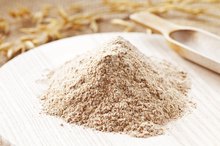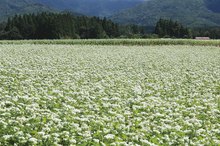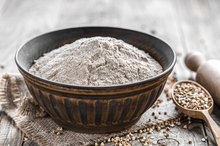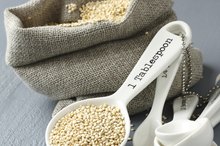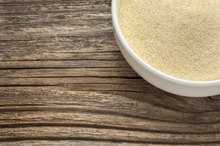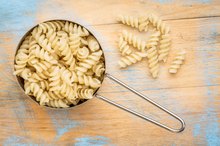What does fact checked mean?
At Healthfully, we strive to deliver objective content that is accurate and up-to-date. Our team periodically reviews articles in order to ensure content quality. The sources cited below consist of evidence from peer-reviewed journals, prominent medical organizations, academic associations, and government data.
The information contained on this site is for informational purposes only, and should not be used as a substitute for the advice of a professional health care provider. Please check with the appropriate physician regarding health questions and concerns. Although we strive to deliver accurate and up-to-date information, no guarantee to that effect is made.
How to Replace Quinoa Flour for Protein Powder
The tiny seedlike grains of quinoa are packed with nutrient power, and this food has become popular as a staple protein. In fact, quinoa contains up to 50 percent more protein than other common grains, and it is also rich in other essential nutrients. Quinoa is eaten whole, and it is also made into flour as an excellent gluten-free alternative to wheat bread and pasta. Protein powder is commonly made from whey, a natural milk protein. However, this can be unsuitable for individuals with a milk allergy or food intolerance. Several commercial protein powders also contain artificial ingredients and flavors. Quinoa flour is a natural, nutrient-rich alternative for protein powders.
Protein Powder
Protein powders are typically used to add protein to a low-fat diet and to supplement food as a way to build muscle strength. These powders often contain whey protein, which is a digestible milk protein. Whey is added to many foods, including bread, ice cream and infant milk formulas. However, it can cause sensitivity reactions in individuals with a food allergy or an intolerance to milk. This can lead to facial swelling, throat itching, skin rashes, vomiting, diarrhea and colic in infants. Quinoa flour is a good alternative to protein powder because it is a natural, whole source of plant protein, and it is not known to cause adverse reactions.
- Protein powders are typically used to add protein to a low-fat diet and to supplement food as a way to build muscle strength.
- These powders often contain whey protein, which is a digestible milk protein.
Quinoa
What Is Sorghum Flour?
Learn More
Quinoa is one of the only plant-based foods that is considered to be a complete protein, as it provides all the essential amino acids. The Whole Grains Council explains that this is due to the unusually high ratio of protein to carbohydrate because the germ, or outer covering, makes up approximately 60 percent of the quinoa grain, while wheat germ, by comparison, makes up only 3 percent of a wheat kernel 2. This makes quinoa a healthy substitute for meat and dairy protein, particularly to control weight, as its high-protein content helps you feel full longer. Quinoa is also a gluten-free option for individuals with wheat allergies.
- Quinoa is one of the only plant-based foods that is considered to be a complete protein, as it provides all the essential amino acids.
- This makes quinoa a healthy substitute for meat and dairy protein, particularly to control weight, as its high-protein content helps you feel full longer.
Nutrients
MayoClinic.com recommends whole grain as a key part of a balanced diet 1. All types of grains are low in fat and a healthy source of complex carbohydrates and essential minerals, vitamins and other nutrients. Though quinoa is not considered a true grain, it is a healthy choice in place of other grains such as wheat. It contains the highest content of potassium, a mineral that is important for heart health, and it helps to control blood pressure levels. According to the Cancer Dietitian website, quinoa contains five grams of fiber per cooked cup; the minerals iron, magnesium, phosphorus, manganese, zinc and copper; and the vitamins thiamin, riboflavin and vitamin B-6.
- MayoClinic.com recommends whole grain as a key part of a balanced diet 1.
- According to the Cancer Dietitian website, quinoa contains five grams of fiber per cooked cup; the minerals iron, magnesium, phosphorus, manganese, zinc and copper; and the vitamins thiamin, riboflavin and vitamin B-6.
Products
Oat Substitutes
Learn More
Quinoa is used in a diverse range of food products. This multifaceted grain is made into breakfast cereals, pastas, breads, baked good, beverages, crackers, biscuits, power bars and more. Quinoa flour can be added to smoothies and protein shakes instead of protein powders. Simply add a spoonful of quinoa flour or powder to a fruit or vegetable and blend until it has a smooth consistency. You can also puree boiled quinoa to add protein to a healthy milkshake. Quinoa is also available in whole-grain form, and you can boil and serve it as side dish in place of rice or other grains, such as couscous 2.
- Quinoa is used in a diverse range of food products.
- Quinoa flour can be added to smoothies and protein shakes instead of protein powders.
Related Articles
References
- MayoClinic.com: Whole Grains: Hearty Options for a Healthy Diet
- Whole Grains Council: Quinoa – March Grain of the Month
- Quinoa, cooked. FoodData Central. U.S. Department of Agriculture. Published April 1, 2019.
- Glycemic Index Food Guide. Diabetes Canada. Updated February 2018.
- Navruz-Varli S, Sanlier N. Nutritional and health benefits of quinoa (Chenopodium quinoa Willd.). J Cereal Sci. 2016;69:371-376. doi:10.1016/j.jcs.2016.05.004
- Giancoli, A. 5 Whole Grains to Keep Your Family Healthy. Academy of Nutrition and Dietetics. Updated August 27, 2018.
- Antioxidants - Protecting Healthy Cells. Academy of Nutrition and Dietetics. Updated March 3, 2020.
- Lim JG, Park HM, Yoon KS. Analysis of saponin composition and comparison of the antioxidant activity of various parts of the quinoa plant (Willd.). Food Sci Nutr. 2020;8(1):694-702. doi:10.1002/fsn3.1358
- Schwingshackl L, Hoffmann G, Lampousi AM, et al. Food groups and risk of type 2 diabetes mellitus: A systematic review and meta-analysis of prospective studies. Eur J Epidemiol. 2017;32(5):363-375. doi:10.1007/s10654-017-0246-y
- Quinoa Allergy. Allergy Knowledge Base. Updated May 16, 2019.
- Kesh S, Barnes CS, Noel-Macdonnell J, Patel NN. Association of quinoa and apple sensitization. J Allergy Clin Immunol. 2018;141(2):AB243. doi:10.1016/j.jaci.2017.12.771
- Types of quinoa. Oldways Whole Grains Council.
Writer Bio
Nadia Haris is a registered radiation therapist who has been writing about nutrition for more than six years. She is completing her Master of Science in nutrition with a focus on the dietary needs of oncology patients.
